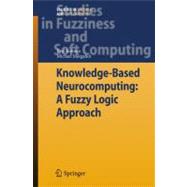
| Preface | p. VII |
| List of Abbreviations | p. IX |
| List of Symbols | p. XI |
| Introduction | p. 1 |
| Artificial Neural Networks (ANNs) | p. 2 |
| Fuzzy Rule-Bases (FRBs) | p. 3 |
| The ANN-FRB Synergy | p. 4 |
| Knowledge-Based Neurocomputing | p. 5 |
| Knowledge Extraction from ANNs | p. 5 |
| Knowledge-Based Design of ANNs | p. 9 |
| The FARB: A Neuro-fuzzy Equivalence | p. 11 |
| The FARB | p. 13 |
| Definition | p. 15 |
| Input-Output Mapping | p. 18 |
| The FARB-ANN Equivalence | p. 21 |
| The FARB and Feedforward ANNs | p. 21 |
| Example 1: Knowledge Extraction from a Feedforward ANN | p. 22 |
| Example 2: Knowledge-Based Design of a Feedforward ANN | p. 24 |
| The FARB and First-Order RNNs | p. 26 |
| First Approach | p. 26 |
| Example 3: Knowledge Extraction from a Simple RNN | p. 27 |
| Second Approach | p. 28 |
| Third Approach | p. 29 |
| Example 4: Knowledge Extraction from an RNN | p. 30 |
| Example 5: Knowledge-Based Design of an RNN | p. 32 |
| The FARB and Second-Order RNNs | p. 33 |
| Summary | p. 35 |
| Rule Simplification | p. 37 |
| Sensitivity Analysis | p. 37 |
| A Procedure for Simplifying a FARB | p. 39 |
| Knowledge Extraction Using the FARB | p. 41 |
| The Iris Classification Problem | p. 41 |
| The LED Display Recognition Problem | p. 44 |
| Knowledge Extraction Using the FARB | p. 46 |
| FARB Simplification | p. 46 |
| Analysis of the FRB | p. 48 |
| The L4 Language Recognition Problem | p. 50 |
| Formal Languages | p. 50 |
| Formal Languages and RNNs | p. 51 |
| The Trained RNN | p. 51 |
| Knowledge Extraction Using the FARB | p. 53 |
| Knowledge-Based Design of ANNs | p. 59 |
| The Direct Approach | p. 60 |
| KBD of an ANN Recognizing L4 | p. 60 |
| The Modular Approach | p. 63 |
| The Counter Module | p. 63 |
| The Sequence-Counter Module | p. 66 |
| The String-Comparator Module | p. 66 |
| The String-to-Num Converter Module | p. 67 |
| The Num-to-String Converter Module | p. 68 |
| The Soft Threshold Module | p. 68 |
| KBD of an RNN for Recognizing the Extended L4 Language | p. 69 |
| KBD of an RNN for Recognizing the AB Language | p. 71 |
| KBD of an RNN for Recognizing the Balanced Parentheses Language | p. 72 |
| KBD of an RNN for Recognizing the 0n 1n Language | p. 74 |
| Conclusions and Future Research | p. 77 |
| Future Research | p. 77 |
| Regularization of Network Training | p. 78 |
| Extracting Knowledge during the Learning Process | p. 79 |
| Knowledge Extraction from Support Vector Machines | p. 79 |
| Knowledge Extraction from Trained Networks | p. 80 |
| Proofs | p. 83 |
| Details of the LED Recognition Network | p. 87 |
| References | p. 89 |
| Index | p. 99 |
| Table of Contents provided by Ingram. All Rights Reserved. |
The New copy of this book will include any supplemental materials advertised. Please check the title of the book to determine if it should include any access cards, study guides, lab manuals, CDs, etc.
The Used, Rental and eBook copies of this book are not guaranteed to include any supplemental materials. Typically, only the book itself is included. This is true even if the title states it includes any access cards, study guides, lab manuals, CDs, etc.